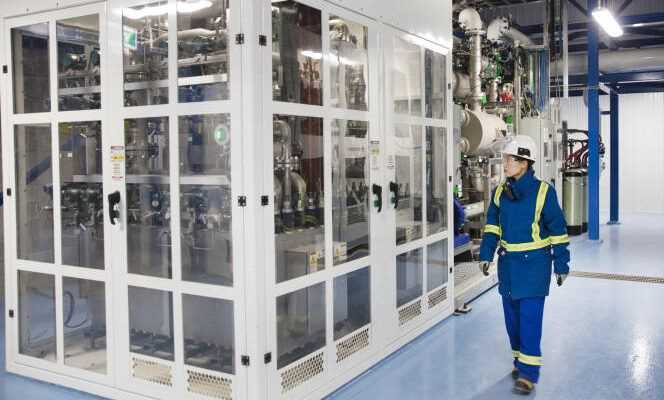The boeotian has a little trouble imagining that in the four glass structures housed by the Air Liquide plant in Bécancour (Quebec), a little larger than our old telephone booths, the energy transition is being played out in part. Classes. But Air Liquide Canada President and CEO Bertrand Masselot is in the affirmative: “On this site, we went from the industrial prototype phase to the industrial production phase of low carbon hydrogen. “
The plant, located on the Quebec-Toronto highway serving the local markets of northeastern Canada and the United States, has doubled its renewable hydrogen production capacity since January. Thanks to the largest proton exchange membrane (PEM) electrolyser in operation in the world today, with a capacity of 20 MW, it produces more than eight tonnes of clean hydrogen per day.
Protected by a helmet, a non-flammable Nomex suit and protective goggles, it is possible to follow the production path of this energy, and to understand why the context is considered promising here. Outside the factory, a few huge pylons supply the site with electricity. Electricity supplied by Hydro-Quebec, a public company that draws almost all of its energy from the province’s hydraulic resources, in particular the James Bay dams, installed in northern Quebec.
“Thermos” on wheels
This abundant and renewable energy is a key asset, it is what makes it possible to produce green hydrogen at a competitive cost. Second stage of the visit, the production of hydrogen: intense electric fields sent to the electrolysers installed in the famous large telephone booths, break the water molecule, previously demineralized, and separate the oxygen from the hydrogen . The electrolysers used here come from Canadian technology Cummins-Hydrogénics, a company in which Air Liquide has taken an 18% stake.
The trick is almost played, there remains an essential step, the compression or liquefaction to – 253 degrees of the hydrogen, in order to concentrate this very light gas and make it transportable. Two gleaming trailer trucks, veritable “thermos” on wheels, await the filling of their tanks: the few molecules of hydrogen which escape at this stage of the operation would be immediately recovered to return to the electrolyser. Nothing is lost, everything is recovered, no rejection of Co2, no unpleasant odor, “We are in a virtuous circle of end-to-end low carbon energy”, explains Bertrand Masselot. The trucks that will crisscross Canada and the United States to transport this clean hydrogen nevertheless continue to run on diesel.
You have 50.73% of this article left to read. The rest is for subscribers only.
